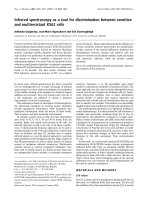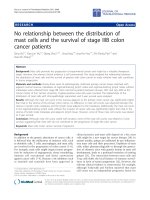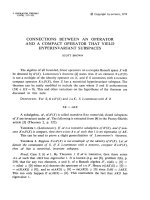Connections between Cells and Cellular Activities
Bạn đang xem bản rút gọn của tài liệu. Xem và tải ngay bản đầy đủ của tài liệu tại đây (1.05 MB, 6 trang )
Connections between Cells and Cellular Activities
Connections between Cells
and Cellular Activities
Bởi:
OpenStaxCollege
You already know that a group of similar cells working together is called a tissue. As
you might expect, if cells are to work together, they must communicate with each other,
just as you need to communicate with others if you work on a group project. Let’s take
a look at how cells communicate with each other.
Extracellular Matrix of Animal Cells
Most animal cells release materials into the extracellular space. The primary
components of these materials are proteins, and the most abundant protein is collagen.
Collagen fibers are interwoven with carbohydrate-containing protein molecules called
proteoglycans. Collectively, these materials are called the extracellular matrix ([link]).
Not only does the extracellular matrix hold the cells together to form a tissue, but it also
allows the cells within the tissue to communicate with each other. How can this happen?
The extracellular matrix consists of a network of proteins and carbohydrates.
1/6
Connections between Cells and Cellular Activities
Cells have protein receptors on the extracellular surfaces of their plasma membranes.
When a molecule within the matrix binds to the receptor, it changes the molecular
structure of the receptor. The receptor, in turn, changes the conformation of the
microfilaments positioned just inside the plasma membrane. These conformational
changes induce chemical signals inside the cell that reach the nucleus and turn “on”
or “off” the transcription of specific sections of DNA, which affects the production of
associated proteins, thus changing the activities within the cell.
Blood clotting provides an example of the role of the extracellular matrix in cell
communication. When the cells lining a blood vessel are damaged, they display a
protein receptor called tissue factor. When tissue factor binds with another factor in
the extracellular matrix, it causes platelets to adhere to the wall of the damaged blood
vessel, stimulates the adjacent smooth muscle cells in the blood vessel to contract (thus
constricting the blood vessel), and initiates a series of steps that stimulate the platelets
to produce clotting factors.
Intercellular Junctions
Cells can also communicate with each other via direct contact, referred to as intercellular
junctions. There are some differences in the ways that plant and animal cells do this.
Plasmodesmata are junctions between plant cells, whereas animal cell contacts include
tight junctions, gap junctions, and desmosomes.
Plasmodesmata
In general, long stretches of the plasma membranes of neighboring plant cells cannot
touch one another because they are separated by the cell wall that surrounds each cell
([link]b). How then, can a plant transfer water and other soil nutrients from its roots,
through its stems, and to its leaves? Such transport uses the vascular tissues (xylem
and phloem) primarily. There also exist structural modifications called plasmodesmata
(singular = plasmodesma), numerous channels that pass between cell walls of adjacent
plant cells, connect their cytoplasm, and enable materials to be transported from cell to
cell, and thus throughout the plant ([link]).
2/6
Connections between Cells and Cellular Activities
A plasmodesma is a channel between the cell walls of two adjacent plant cells. Plasmodesmata
allow materials to pass from the cytoplasm of one plant cell to the cytoplasm of an adjacent cell.
Tight Junctions
A tight junction is a watertight seal between two adjacent animal cells ([link]). The
cells are held tightly against each other by proteins (predominantly two proteins called
claudins and occludins).
Tight junctions form watertight connections between adjacent animal cells. Proteins create tight
junction adherence. (credit: modification of work by Mariana Ruiz Villareal)
This tight adherence prevents materials from leaking between the cells; tight junctions
are typically found in epithelial tissues that line internal organs and cavities, and
comprise most of the skin. For example, the tight junctions of the epithelial cells lining
your urinary bladder prevent urine from leaking out into the extracellular space.
Desmosomes
Also found only in animal cells are desmosomes, which act like spot welds between
adjacent epithelial cells ([link]). Short proteins called cadherins in the plasma membrane
connect to intermediate filaments to create desmosomes. The cadherins join two
adjacent cells together and maintain the cells in a sheet-like formation in organs and
tissues that stretch, like the skin, heart, and muscles.
3/6
Connections between Cells and Cellular Activities
A desmosome forms a very strong spot weld between cells. It is created by the linkage of
cadherins and intermediate filaments. (credit: modification of work by Mariana Ruiz Villareal)
Gap Junctions
Gap junctions in animal cells are like plasmodesmata in plant cells in that they are
channels between adjacent cells that allow for the transport of ions, nutrients, and
other substances that enable cells to communicate ([link]). Structurally, however, gap
junctions and plasmodesmata differ.
A gap junction is a protein-lined pore that allows water and small molecules to pass between
adjacent animal cells. (credit: modification of work by Mariana Ruiz Villareal)
Gap junctions develop when a set of six proteins (called connexins) in the plasma
membrane arrange themselves in an elongated donut-like configuration called a
connexon. When the pores (“doughnut holes”) of connexons in adjacent animal cells
align, a channel between the two cells forms. Gap junctions are particularly important
in cardiac muscle: The electrical signal for the muscle to contract is passed efficiently
through gap junctions, allowing the heart muscle cells to contract in tandem.
Link to Learning
4/6
Connections between Cells and Cellular Activities
To conduct a virtual microscopy lab and review the parts of a cell, work through the
steps of this interactive assignment.
Section Summary
Animal cells communicate via their extracellular matrices and are connected to each
other via tight junctions, desmosomes, and gap junctions. Plant cells are connected and
communicate with each other via plasmodesmata.
When protein receptors on the surface of the plasma membrane of an animal cell bind
to a substance in the extracellular matrix, a chain of reactions begins that changes
activities taking place within the cell. Plasmodesmata are channels between adjacent
plant cells, while gap junctions are channels between adjacent animal cells. However,
their structures are quite different. A tight junction is a watertight seal between two
adjacent cells, while a desmosome acts like a spot weld.
Review Questions
Which of the following are found only in plant cells?
1.
2.
3.
4.
gap junctions
desmosomes
plasmodesmata
tight junctions
C
The key components of desmosomes are cadherins and __________.
1.
2.
3.
4.
actin
microfilaments
intermediate filaments
microtubules
C
5/6
Connections between Cells and Cellular Activities
Free Response
How does the structure of a plasmodesma differ from that of a gap junction?
They differ because plant cell walls are rigid. Plasmodesmata, which a plant cell
needs for transportation and communication, are able to allow movement of really
large molecules. Gap junctions are necessary in animal cells for transportation and
communication.
Explain how the extracellular matrix functions.
The extracellular matrix functions in support and attachment for animal tissues. It also
functions in the healing and growth of the tissue.
6/6









